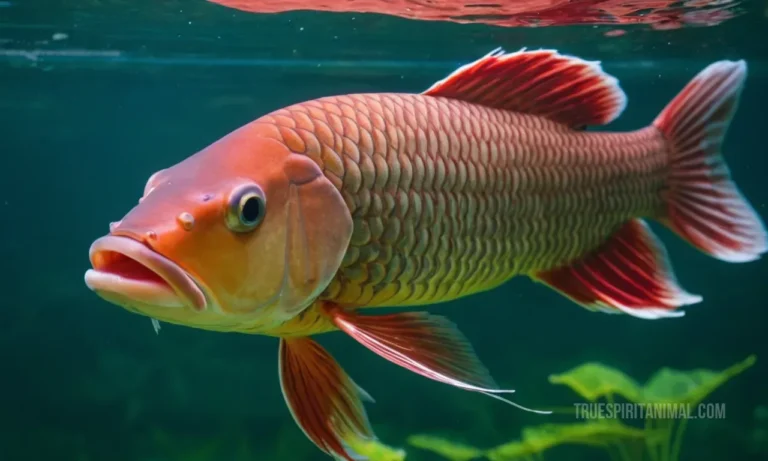Arapaima Symbolism and Meaning

The Arapaima is a fascinating creature that holds significant symbolic meaning in the cultures of South America, particularly among indigenous communities. This article will explore its symbolism and meaning, providing an insight into the rich cultural history behind this unique fish species.
Introduction
Arapaima, also known as Pirarucu or Paiche, is a large freshwater fish native to the Amazon Basin in South America. It’s one of the largest scaled fish in the world and can grow up to 10 feet long and weigh over 400 pounds. This prehistoric-looking creature has been an essential part of the diet and culture of indigenous communities for centuries, symbolizing various aspects of life, nature, and spirituality. In this article, we will delve into the Arapaima’s symbolism and meaning in South American cultures, its physical characteristics, and how it has shaped their beliefs and traditions.
Physical Characteristics
The Arapaima is a unique fish with several distinctive features that make it stand out from other species. It has a long, elongated body covered in large scales, a long dorsal fin, and a mouth full of sharp teeth. Its most striking feature is the air bladder, which allows it to breathe air when submerged underwater. This adaptation enables it to survive in shallow waters with low oxygen levels. The Arapaima can also be found in the Amazon River’s murky waters, where other fish struggle due to its ability to extract dissolved gases from the atmosphere through its skin. Its unique characteristics have made it an iconic symbol of survival and adaptation in South American cultures.
Symbolism in Indigenous Cultures
The Arapaima holds deep cultural significance for indigenous communities, particularly in Brazil, Peru, Colombia, and other Amazonian countries. In these regions, the fish is often associated with strength, resilience, and adaptability. Its ability to survive in harsh environments has made it a symbol of endurance and perseverance. The Arapaima’s air bladder represents the spirit of overcoming challenges and thriving despite adversity.
Strength and Resilience
The Arapaima is seen as a representation of strength due to its physical attributes and survival skills. Its ability to survive in low-oxygen environments symbolizes resilience, which resonates with many indigenous tribes who live in similar conditions. They believe that by embodying the fish’s qualities, they too can overcome hardships and thrive in their environment. The fish is often depicted in tribal art and mythology as a symbol of power and determination.
Adaptability
The Arapaima’s ability to adapt to various environments has made it a symbol of adaptability. Indigenous tribes view the fish as an emblem of flexibility and resourcefulness, teaching them to adapt to changing circumstances. They believe that by learning from the Arapaima, they can face life’s challenges with grace and agility.
Spiritual Significance
In some indigenous cultures, the Arapaima is considered sacred. It represents spiritual growth and transformation. The fish is believed to possess healing properties, used in traditional medicine and rituals for physical and emotional well-being. Its meat is considered a delicacy, often served during special occasions or ceremonies, signifying unity and community bonding.
Cultural Significance
The Arapaima is central to their culinary traditions. It’s a staple food source for many tribes, symbolizing abundance and prosperity. The fish’s presence in their diet reflects their connection with nature and respect for the environment.
Meaning in Art and Literature
Arapaima appears in various forms of art, from tattoos to pottery designs. Its image is often used as a representation of power and strength. In literature, it symbolizes survival against all odds, reflecting the indigenous people’s resilience in harsh conditions.
Artistic Representation
Arapaima artwork showcases its physical attributes, emphasizing its unique features like scales, teeth, and air bladder. These designs are found on pottery, body paintings, and tattoos, representing strength and adaptability.
Literary Symbolism
The Arapaima is a recurring character in Amazonian folklore, often portrayed as a wise creature offering guidance during difficult times. Stories depict it as a symbol of survival and resourcefulness, reflecting the tribes’ resilience in adverse situations.
Conclusion
In conclusion, the Arapaima holds immense cultural significance for South American communities. Its physical attributes, adaptability, and spiritual importance make it an essential part of their culture. The fish symbolizes strength, resilience, and adaptability, teaching valuable life lessons. It’s a reminder of survival in challenging environments and unity within the community. As a delicacy, it represents abundance and prosperity. Its presence in art and literature highlights its importance to indigenous people’s identity and connection with nature. The Arapaima is more than just a fish; it’s a symbol of their heritage and values.





